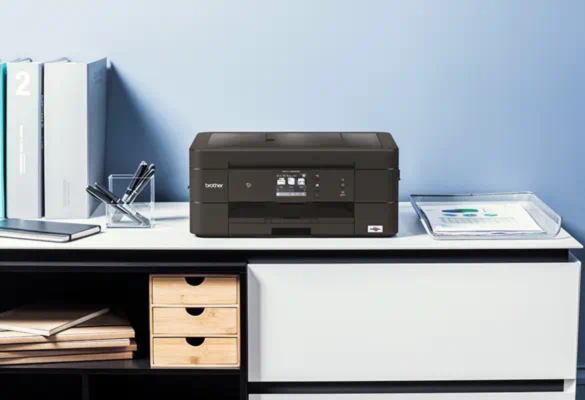Sublimation printing has become a popular method for creating vibrant, high-quality designs on a variety of materials, including fabric, mugs, and metal. If you’re a DIY enthusiast or an entrepreneur looking to enter the world of sublimation printing, you might already own a Brother printer and wonder if it can be converted for sublimation use. The good news is that you can easily convert a Brother printer into a sublimation printer at home with a few simple steps. In this guide, we will walk you through the process, so you can start creating custom designs with your Brother printer.
What is Sublimation Printing?
Sublimation printing is a heat-based process where special sublimation ink is transferred onto a substrate (such as polyester fabric, ceramics, or metal) using a heat press. When the ink is heated, it turns into a gas and bonds with the surface on a molecular level, resulting in vibrant, long-lasting designs that won't crack or fade over time. This makes sublimation printing ideal for custom products like t-shirts, mugs, and promotional items.
Can You Convert a Brother Printer to Sublimation Printing?
Yes! Converting a Brother printer to sublimation printing is entirely possible. Brother printers, such as the Brother HL-L2370DW or Brother MFC series, are commonly used for sublimation because they are reliable, affordable, and work well with the necessary ink. However, it’s important to note that you cannot simply use the ink that comes with a standard Brother printer. You’ll need to replace the standard ink cartridges with sublimation ink and make a few modifications to ensure the best results.
Why Convert Your Brother Printer to Sublimation?
There are several reasons you might want to convert your Brother printer into a sublimation printer:
- Cost-Effective: Sublimation printers can be expensive, but converting an existing Brother printer allows you to enter the world of sublimation printing without breaking the bank.
- Customization: Converting your printer opens the door to creating high-quality, custom prints on a variety of materials, from t-shirts and mugs to phone cases and more.
- Business Opportunity: Whether you’re looking to start a small business or expand your current one, sublimation printing can provide an affordable way to offer custom products to customers.
How to Convert a Brother Printer to Sublimation Printing
The conversion process requires a few tools and materials, and it’s essential to follow the steps carefully to achieve the best results. Here's a step-by-step guide:
1. Gather the Necessary Supplies
Before you start the conversion process, make sure you have all the necessary materials:
- Brother Printer (any model compatible with sublimation ink, such as Brother HL-L2370DW or Brother MFC)
- Sublimation Ink: Purchase sublimation ink compatible with Brother printers. Brands like Sawgrass, Hiipoo, or Printers Jack offer sublimation ink specifically designed for use with Brother printers.
- Sublimation Ink Cartridges or Refillable Cartridges: If your Brother printer uses standard ink cartridges, you’ll need to either purchase sublimation ink cartridges or refillable cartridges.
- Sublimation Paper: Use high-quality sublimation paper for transferring your designs to the substrate.
- Heat Press Machine: To transfer your designs to the material, you’ll need a heat press machine.
- Protective Gloves: Always wear gloves when handling hot equipment to avoid burns.
2. Replace the Standard Ink with Sublimation Ink
The first step in converting your Brother printer for sublimation printing is to replace the regular ink cartridges with sublimation ink. Follow these steps:
- Remove the Standard Ink Cartridges: Open your printer’s cartridge compartment and carefully remove the standard ink cartridges.
- Install Sublimation Ink: Install the sublimation ink cartridges into the printer. If your printer uses refillable cartridges, you will need to refill the cartridges with sublimation ink manually.
Tip: Always use sublimation-specific ink for the best results. Using regular ink can cause issues with print quality and damage the printhead.
3. Perform a Printer Head Cleaning
After installing the sublimation ink, it’s important to clean the printer head to ensure the ink flows smoothly and the colors print accurately. Most Brother printers have a built-in cleaning function that you can access through the printer’s control panel or software.
- Run a Cleaning Cycle: Use the cleaning function on the printer to flush out any residual ink and clear the printhead.
- Test the Print: After cleaning, run a test print to check for any ink clogs or misalignment.
4. Download and Install Sublimation Software
To create your custom designs, you’ll need design software that supports sublimation printing. Programs like Adobe Photoshop, CorelDRAW, and Adobe Illustrator are excellent choices. You will also need to ensure that your Brother printer is properly connected to your computer and set up in the printing software.
- Create or Import Your Design: Design your artwork in your preferred software, ensuring it is sized correctly for your material. Remember to mirror your design if you’re printing on transfer paper.
- Select the Sublimation Printer: In your printing software, select your Brother printer and adjust the print settings to match the type of paper you’re using.
5. Print Your Design
Load the sublimation paper into your Brother printer and ensure the printer is set to the correct paper type and print quality. Print your design using the sublimation settings in your software.
Tip: Make sure to mirror your design before printing, especially when transferring onto t-shirts or other fabric materials.
6. Heat Transfer the Design
Once your design is printed on sublimation paper, use a heat press machine to transfer the design onto your chosen material. Follow these steps:
- Set the Heat Press Temperature: For fabric, set the heat press to around 400°F (204°C), and press for 45-60 seconds. For other materials like mugs or metal, adjust the temperature accordingly.
- Position the Paper on the Material: Place the sublimation paper with the printed design onto the material and secure it with heat-resistant tape.
- Press the Design: Close the heat press and apply pressure and heat for the required time.
7. Enjoy Your Custom Prints
After the heat press cycle is complete, carefully remove the material and let it cool before peeling off the sublimation paper. You’ll now have a vibrant, high-quality custom design transferred onto your chosen material.
Conclusion
Converting your Brother printer to sublimation printing is a simple process that can open up a world of creative possibilities. By replacing the standard ink with sublimation ink, performing a few printer maintenance tasks, and using the correct materials, you can start creating stunning custom designs at home. Whether for personal use or a small business venture, sublimation printing offers endless opportunities for customization and creativity.
References
- How to Convert Your Printer to Sublimation Printing. Sawgrass. Link to source.



Comments ()